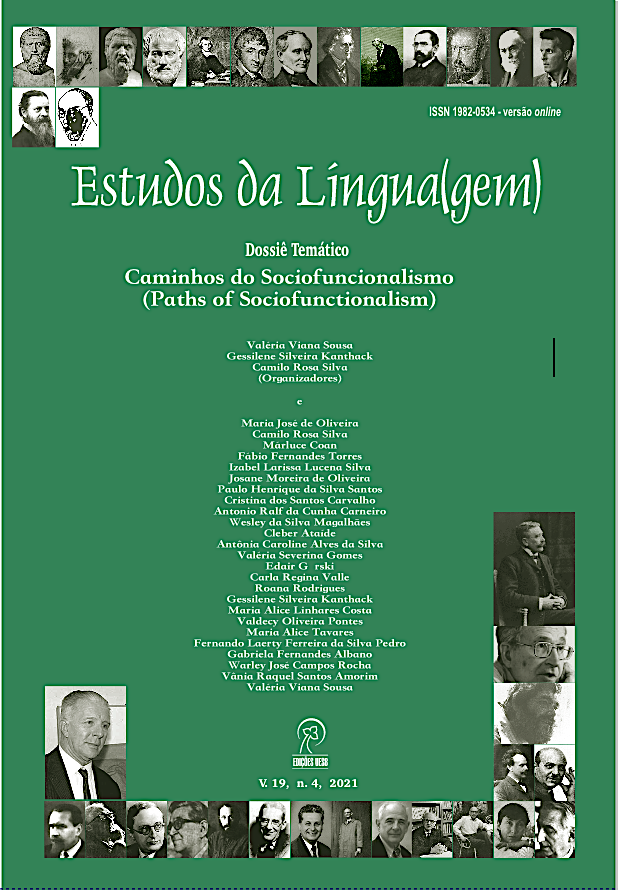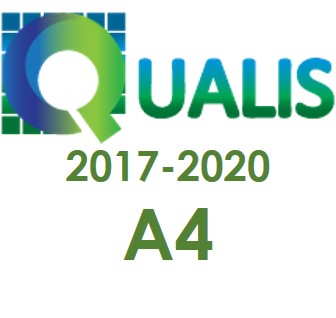Gramaticalización de la construcción porque de en el portugués de Valença-BA: dominio de la relación causal y posición del sintagma preposicional
DOI:
https://doi.org/10.22481/el.v19i4.7960Palabras clave:
Porque de, Gramaticalização, SociofuncionalismoResumen
Este artículo presenta algunos resultados de la investigación que tuvo como objetivo describir el conector porque de, considerado una construcción que, cuando surge a través de la gramaticalización, moviliza una unión causal entre frases oracionales. Si bien el uso de esta construcción parece generalizado, no existían estudios sobre este conector, lo que llevó a la hipótesis de que se trata de una construcción resultante de un reciente proceso de gramaticalización. El marco teórico es el del Sociofuncionalismo, que combina el Funcionalismo lingüístico norteamericano y la Sociolingüística. A partir del análisis cuantitativo de los datos, y considerando los supuestos y mecanismos responsables de desencadenar la gramaticalización, se encontró que, por analogía con la forma más prototípica por causa de y sus correlatos (por conta de, por razão de etc.), los hablantes de Valença-BA están dando un nuevo uso al conector porque, al integrarse con la preposición de, comienza a componer una frase preposicional basada en un patrón constructivo type para conector de causalidad.
Descargas
Citas
AMORIM, F. S. Gramaticalização de conectores causais na história do português. 2017. 212 fl. Tese (Doutorado em Estudos Linguísticos) – Programa de Pós-Graduação em Estudos Linguísticos da Universidade Estadual Paulista Júlio de Mesquita Filho, São José do Rio Preto, 2017.
BECHARA, E. Gramática escolar da língua portuguesa. Rio de Janeiro: Nova Fronteira, 2010.
BOLINGER, D. Meaning and form. London: Longman, 1977.
BYBEE, J.; PERKINS, R. D.; PAGLIUCA, W. The evolution of grammar. Tense, aspect, and modality in the languages of the world. Chicago: University of Chicago Press, 1994.
CASTILHO, A. T. Gramática do português brasileiro. São Paulo: Contexto, 2010.
CEZÁRIO, M. M.; PINTO, D. C. M; ALONSO, K. S. B. Trajetórias: Mário Martelotta e os estudos em gramaticalização. In: CEZÁRIO, M. M.; CUNHA, M. A. F. (Org.). Linguística centrada no uso: uma homenagem a Mário Martelotta. Rio de Janeiro: Mauad X: FAPERJ, 2013, p. 41-58.
CROFT, W. Radical construction grammar: syntactic theory in typological perspective. Oxford: Oxford University Press, 2001.
DEGAND, L.; FAGARD, B. Intersubjectification des connecteurs. Le cas de car et parce que. Revista de Estudos Linguísticos da Universidade do Porto, Porto, n. 3 (1), p. 119-136, 2008. Disponível em: http://ojs.letras.up.pt/index.php/EL/article/view/2810. Acesso em 13 jan. 2020.
DIK, S. C. The theory of functional grammar. Dordrecht/Providence: Foris Publications, 1989.
DU BOIS, J. W. Competing motivations. In: HAIMAN, J. (Ed.). Iconicity in syntax. Amsterdam: John Benjamins, 1985, p. 343-365.
GIVÓN, T. Functionalism and grammar. Amsterdam: John Benjamins, 1995.
GIVÓN, T. From discourse to syntax: grammar as a processing strategy. In: GIVÓN, T. (Org.). Syntax and semantics: discourse and syntax. v. 12. New York: Academic Press, p. 81-112, 1979.
HALLIDAY, M. A. K. An introduction to functional grammar. London: Edward Arnold, 1985.
HEINE, B.; CLAUDI, U.; HÜNEMEYER, F. Grammaticalization: a conceptual framework. Chicago: University of Chicago Press, 1991.
HOPPER, P. J. On some principles of grammaticization. In: TRAUGOTT, E. C.; HEINE, B. (Ed.). Approaches to grammaticalization. v. 1. Philadelphia: John Benjamins, 1991, p. 17-35.
HOPPER, P. J.; THOMPSON, S. A. Transitivity in grammar and discourse. Language, v. 56, p. 251-299, 1980. Disponível em: http://latina.phil2.uni-freiburg.de/raible/Lehre/2006/Materialien/Hopper_Thompson.pdf. Acesso em: 13 jan. 2020.
HOPPER, P. J.; TRAUGOTT, E. C. Grammaticalization. Cambridge: Cambridge University Press, 1993.
LABOV, W. Padrões sociolinguísticos. Tradução de Marcos Bagno, Marta Scherre e Caroline R. Cardoso. São Paulo: Parábola, 2008 [1972].
MARTELLOTA, M. E.; KENEDY, E. A visão funcionalista da linguagem no século XX. In: CUNHA, M. A. F.; OLIVEIRA, M. R.; MARTELOTTA, M. E. (Org.). Linguística funcional: teoria e prática. São Paulo: Parábola, 2015.
MEILLET, A. Linguistique historique et linguistique générale. Paris: Champion, 1912.
NEVES, M. H. M. A gramática funcional. São Paulo: Martins Fontes, 1997.
NEVES, M. H. M. As construções causais. In: NEVES, M. H. M. (Org.). Gramática do português falado. v. VII: Novos estudos. São Paulo: Humanitas/FFLCH/USP; Campinas: Editora da Unicamp, 1999, p. 461-496.
NEVES, M. H. M. Gramática de usos do português. São Paulo: Unesp, 2000.
NEVES, M. H. M. Texto e gramática. São Paulo: Contexto, 2006.
PAIVA, M. C. Ordenação de cláusulas causais: forma e função. 1991. 232 fl. Tese (Doutorado em Linguística) – Programa de Pós-Graduação em Linguística da Universidade Federal do Rio de Janeiro, Rio de Janeiro, 1991.
PERINI, M. A. Gramática do português brasileiro. São Paulo: Parábola, 2010.
ROCHA LIMA, C. H. Gramática normativa da língua portuguesa. Rio de Janeiro: José Olympio, 2010.
SANKOFF, D.; TAGLIAMONTE, S.; SMITH, E. GoldVarb X – a multivariate analysis application. 2005. Toronto: Department of Linguistics; Ottawa: Department of Mathematics. Disponível em: http://individual.utoronto.ca/tagliamonte/ Goldvarb/GV_index.htm#ref. Acesso em: 20 jun. 2019.
SANTOS, P. H. S. Gramaticalização da construção porque de no português de Valença-BA. 2020. 140 fl. Dissertação (Mestrado em Estudos Linguísticos) – Programa de Pós-Graduação em Estudos Linguísticos da Universidade Estadual de Feira de Santana, Feira de Santana, 2020.
SWEETSER, E. From etymology to pragmatics: metaphorical and cultural aspects of semantic structure. New York: Cambridge University Press, 1990.
TAVARES, M. A. A gramaticalização de e, aí, daí e então: estratificação/variação e mudança no domínio funcional da sequenciação retroativo-propulsora de informações – um estudo sociofuncionalista. 2003. 400 fl. Tese (Doutorado em Linguística) – Programa de Pós-Graduação em Linguística da Universidade Federal de Santa Catarina, Florianópolis, 2003.
TAVARES, M. A.; GÖRSKI, E. M. Variação e sociofuncionalismo. In: MARTINS, M. A.; ABRAÇADO, J. (Org.). Mapeamento sociolinguístico do português brasileiro. São Paulo: Contexto, 2015, p. 249-270.
TRAUGOTT, E. C. (Inter)subjectivity and (inter)subjectification: a reassessment. In: DAVIDSE et al. (Ed.). Subjectification, intersubjectification and grammaticalization. Topics in English Linguistics. Berlin/New York: Mouton De Gruyter, 2010, p. 29-74.
TRAUGOTT, E. C.; HEINE, B. (Ed.). Approaches to grammaticalization. Philadelphia: John Benjamins, 1991.
WEINREICH, U.; LABOV, W.; HERZOG, M. I. Fundamentos empíricos para uma teoria da mudança linguística. Tradução de Marcos Bagno. São Paulo: Parábola, 2006 [1968].
Descargas
Publicado
Cómo citar
Número
Sección
Licencia
Derechos de autor 2021 Estudios del lenguaje

Esta obra está bajo una licencia internacional Creative Commons Atribución 4.0.

Estudos da Língua(gem) está bajo una Licencia Creative Commons Atribución 4.0 Internacional.
Los autores que publican en el periódico Estudios de la Lengua (g) concuerdan con los siguientes términos:
La revista Estudios del Lenguaje mantiene los derechos de autor de las contribuciones publicadas. Estos derechos incluyen la publicación de la contribución y pondrá a disposición su contenido gratuitamente a través del portal







